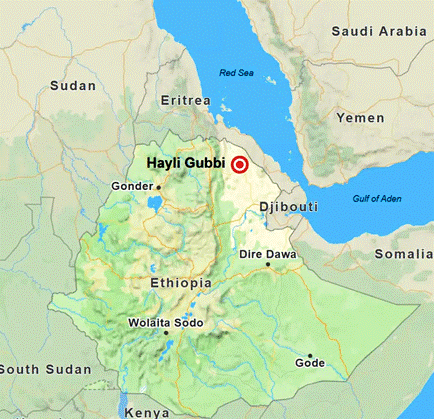Why is it in News?
- Erupted on 23 November 2025 after being dormant for ~12,000 years.
- Produced an explosive ash-rich eruption, unusual for a shield volcano.
- Located in the Afar Region, a tectonically sensitive area within the East African Rift System.
- Eruption monitored mainly via satellite imagery due to remoteness.
Relevance:
GS1 – Geography
- Shield volcano characteristics; Afar Rift tectonics; triple-junction dynamics.
- Dormant volcano reactivation after millennia; magma chemistry.
- Rift-related volcanism → creation of future ocean basin.
GS3 – Disaster Management
- Monitoring challenges in remote volcanic systems.
- Role of satellite-based early warning; preparedness gaps.

What is a Shield Volcano?
- Broad, gently sloping volcanic structure.
- Formed by multiple thin, fluid basaltic lava flows.
- Low viscosity magma → flows long distances → “warrior’s shield” shape.
- Typically non-explosive eruptions due to low gas content.
Location & Tectonic Setting
- Situated in Afar, Ethiopia, part of the Erta Ale volcanic range.
- Lies on the boundary of:
- African Plate
- Arabian Plate
- Region forms a triple junction (Afar Triple Junction).
- Part of the active East African Rift, where continents are pulling apart (divergent plate boundary).
Geological Composition of Hayli Gubbi
- Dominantly basaltic lava (dark, fluid).
- Also contains trachyte and rhyolite (higher silica content).
- High-silica magma → more viscous → traps gases → explosive potential.
Why Did the Eruption Occur Now After 12,000 Years?
Tectonic Drivers
- Rifting continues → plates pulling apart.
- This allows hot mantle material to rise.
Magma Generation
- Rising mantle undergoes partial melting.
- Fresh magma accumulates in shallow crustal chambers.
Long-term Magma Buildup
- Over millennia:
- Magma slowly pressurises surrounding rocks.
- Gas-rich, silica-rich pockets evolve.
Crustal Faulting or Cracking
- Rifting causes fault slippage or crustal fractures.
- A new pathway to the surface opens suddenly.
Sudden Ascent of Gas-Rich Magma
- Once pathway opens:
- Pressurised magma rises rapidly.
- Dissolved gases expand into bubbles → explosive eruption.
- Explains why a shield volcano (usually gentle) produced ash-heavy explosive activity.
Why Was It Explosive This Time?
- Presence of more silica-rich magmas (trachyte, rhyolite).
- These magmas:
- Viscous, slow-flowing → gas cannot escape.
- High gas content → explosive release when decompressed.
- Long dormancy → pressure buildup significant.
Monitoring Challenges
- Region is remote, poorly instrumented.
- Very limited seismic stations, gas sensors, ground deformation tools.
- Scientists rely on:
- Satellites (thermal anomalies, ash plume movement).
- Ash chemistry samples.
- Infrasound and remote radar.
- Current assessments are provisional, pending better data.
Broader Geological Significance
- Shows that rift-zone volcanoes can reawaken after millennia.
- Demonstrates mixed-magma systems in shield volcanoes.
- Highlights the dynamic nature of the East African Rift → one of the few places on Earth where a new ocean basin is forming.



